Paper翻译:《MobileNet Based Apple Leaf Diseases Identification》
Posted JasonYangQ
tags:
篇首语:本文由小常识网(cha138.com)小编为大家整理,主要介绍了Paper翻译:《MobileNet Based Apple Leaf Diseases Identification》相关的知识,希望对你有一定的参考价值。
- 论文名称:《MobileNet Based Apple Leaf Diseases Identification》
- 论文作者: Chao X , Sun G , Zhao H , et al.
- 发表期刊:Mobile Networks and Applications, 2020(10).
- 论文总结:
- Research Gap:
基于MobileNet的苹果叶病害识别 - Importance:
MobileNet对2类苹果病理叶片的ACC为73.5%,识别速度为每张图片0.22s - Limitations:
苹果叶部病理分类类别较少
没有对MobileNet进行改进
Abstract
| 原文 | 译文 |
|---|---|
Alternaria leaf blotch, and rust are two common types of apple leaf diseases that severely affect apple yield. A timely andeffective detection of apple leaf diseases is crucial for ensuring the healthy development of the apple industry. In general,these diseases are inspected by experienced experts one by one. This is a time-consuming task with unstable precision.Therefore, in this paper, we proposed a LOW-COST, STABLE, HIGH precision apple leaf diseases identification method.This is achieved by employing MobileNet model. Firstly, comparing with general deep learning model, it is a LOW-COST model because it can be easily deployed on mobile devices. Secondly, instead of experienced experts, everyone can finish the apple leaf diseases inspection STABLELY by the help of our algorithm. Thirdly, the precision of MobileNet is nearlythe same with existing complicated deep learning models. Finally, in order to demonstrated the effectiveness of ourproposed method, several experiments have been carried out for apple leaf diseases identification. We have compared the efficiency and precision with the famous CNN models: i.e. ResNet152 and InceptionV3. Here, the apple disease datasets (including classes: Alternaria leaf blotch and rust leaf) were collected by the agriculture experts in Shaanxi Province, China. | 链格孢叶斑病和锈病是严重影响苹果产量的两种常见的苹果叶病。及时有效地发现苹果叶片病害,是保障苹果产业健康发展的关键。一般来说,这些疾病都是由有经验的专家一一检查。这是一项耗时且精度不稳定的任务。因此,在本文中,我们提出了一种低成本、稳定、高精度的苹果叶病识别方法。这是通过采用 MobileNet 模型实现的。首先,与一般的深度学习模型相比,它是一个低成本的模型,因为它可以很容易地部署在移动设备上。其次,在我们的算法的帮助下,每个人都可以稳定地完成苹果叶病检查,而不是有经验的专家。第三,MobileNet 的精度与现有复杂的深度学习模型几乎相同。最后,为了证明我们提出的方法的有效性,对苹果叶片病害的识别进行了多次实验。我们已经将效率和精度与著名的 CNN 模型进行了比较:即 ResNet152 和 InceptionV3。这里,苹果病害数据集(包括类:链格孢叶斑病和锈叶)由中国陕西省的农业专家收集。 |
| Keywords: Keywords: Apple leaf diseases . Mobile device . MobileNet . Deep learning | 关键词: 苹果叶病;移动设备 ;MobileNet;深度学习 |
1.Introduction
| 原文 | 译文 |
|---|---|
With a high nutritional and medicinal value, apple is one of the most productive types of fruit in the world. However,various diseases occur frequently on a large scale in apple production, such as Apple Alternaria leaf blotch (caused by Alternaria alternata f.sp. mali), and Apple rust (caused by Pucciniaceae glue rust), which affect the quality of fruits and thereby causing substantial economic losses. | 苹果具有很高的营养和药用价值,是世界上产量最高的水果之一。 然而,苹果生产中经常发生各种病害,如苹果链格孢叶斑病(由马里链格孢引起)、苹果锈病(由柄锈菌引起),影响果实品质和品质。 从而造成重大经济损失。 |
| Currently, the apple leaf diseases are mainly inspected by experienced experts. They need to check the apple leaves one by one. This is a huge job. The number of leaves for one apple tree is large enough. For a whole apple yield, we do not have enough experienced experts to finish such kind of inspection task. Furthermore, a large number of errors will be appeared when these experts become tired, especially for some similar leaf diseases. | 目前,苹果叶片病害主要由经验丰富的专家进行检查。 他们需要一张一张地检查苹果的叶子。 这是一项巨大的工作。 一棵苹果树的叶子数量足够大。 对于整个苹果的产量,我们没有足够的经验丰富的专家来完成这样的检查任务。 再者,当这些专家累了,就会出现大量的错误,特别是对于一些类似的叶病。 |
| Therefore, we need an algorithm to help farmers to resolve this problem. This algorithm can let non-experience-farmers to identify these apple leaf diseases without the helps from experts. This algorithm should have the following 3 merits: – Stable: the method should have the ability to identify the similar apple leaf diseases. – Low Cost: the method could be simply used in mobile devices. – Efficiency & Precision: the disease should be identified in less than one second with high precision. | 因此,我们需要一种算法来帮助农民解决这个问题。 该算法可以让没有经验的农民在没有专家帮助的情况下识别这些苹果叶病。 该算法应具有以下3个优点: – 稳定:该方法应具有识别相似苹果叶病害的能力。 – 低成本:该方法可以简单地用于移动设备。 – 效率和精度:应在不到一秒的时间内以高精度识别疾病。 |
| However, current existing researches cannot fully satisfy these three issues for apple leaf diseases identification. We divided existing approaches into two classifications: inspection by experienced experts, and inspection by using deep learning methods. Here, the withdraws of experienced experts’ inspection have been described in previous paragraph. On the other hand, deep learning method cannot be used for apple leaf diseases identification directly. This is because these models are too complex to be used on mobile device directly. | 然而,目前现有的研究还不能完全满足苹果叶片病害识别的这三个问题。 我们将现有方法分为两类:经验丰富的专家检查和使用深度学习方法的检查。 这里,有经验的专家检查的退出在前一段已经描述过。 另一方面,深度学习方法不能直接用于苹果叶片病害识别。 这是因为这些模型太复杂,无法直接在移动设备上使用。 |
| In this paper, we built a mobile-based model for apple leaf diseases identification based on MobileNet. This model is a mobile version CNN model. Its precision is nearly the same as the general CNN model. Meanwhile, its efficiency is high enough for apple leaf diseases identification. In our method, firstly, in order to let the disease identification as STABLE as possible, we have invited the agriculture experts from Chinese Academy of Agricultural Sciences, China for obtaining all kinds of leaves with different apple leaf diseases. These datasets are taken from Shaanxi Province, China. Note that, we have mainly used two kinds of diseases (Alternaria leaf blotch and Apple rust) to demonstrate the effectiveness of our proposed method. Secondly, in order to satisfy the LOWCOST issue, the MobileNet model is employed for apple leaf diseases identification. This is because it can be easily deployed on mobile devices. Finally, in order to achieve the goal of HIGH efficiency and precision, the MobileNet model is optimized according to the features of apple leaf diseases. Furthermore, we have also tried several other models. As a result, the MobileNet model is the best choice. A balance of efficiency and precision is achieved by using MobileNet for apple leaf diseases identification. | 在本文中,我们基于 MobileNet 构建了一个基于移动的苹果叶病识别模型。这个模型是手机版的CNN模型。它的精度与一般的CNN模型几乎相同。同时,其效率对于苹果叶片病害的识别也足够高。在我们的方法中,首先,为了让病害鉴定尽可能稳定,我们邀请了中国农业科学院的农业专家来获取各种不同苹果叶片病害的叶子。这些数据集来自中国陕西省。请注意,我们主要使用两种疾病(链格孢叶斑病和苹果锈病)来证明我们提出的方法的有效性。其次,为了满足低成本问题,采用MobileNet模型进行苹果叶片病害识别。这是因为它可以轻松部署在移动设备上。最后,为了达到高效、精准的目标,根据苹果叶片病害的特点对MobileNet模型进行了优化。此外,我们还尝试了其他几种模型。因此,MobileNet 模型是最佳选择。通过使用 MobileNet 进行苹果叶病害识别,实现了效率和精度的平衡。 |
| The remainder of this paper is organized as follows. Section 2 provides a brief survey on apple leaf diseases identification. Section 3 introduces the dataset construction for obtaining stable identification results. Section 4 describes MobileNet based apple leaf diseases identification method; followed by another two famous CNN models: i.e. ResNet152 and InceptionV3 for comparing with MobileNet model on apple leaf diseases inspection in Section 5. Section 6 discusses the effectiveness of our method through comparing with ResNet152 and InceptionV3 models. Section 7 concludes the paper with future extensions. | The remainder of this paper is organized as follows. Section 2 provides a brief survey on apple leaf diseases identification. Section 3 introduces the dataset construction for obtaining stable identification results. Section 4 describes MobileNet based apple leaf diseases identification method; followed by another two famous CNN models: i.e. ResNet152 and InceptionV3 for comparing with MobileNet model on apple leaf diseases inspection in Section 5. Section 6 discusses the effectiveness of our method through comparing with ResNet152 and InceptionV3 models. Section 7 concludes the paper with future extensions. |
2 Related work
| 原文 | 译文 |
|---|---|
| In this section, we will simply introduce the traditional apple leaf diseases identification method in Section 2.1. The development of traditional Convolutional Neural Networks is described in Section 2.2, followed by the lightweight Convolutional Neural Networks in Section 2.3. In this paper, we need a balance of precision and efficiency. Therefore, a lightweight model (MobileNet) is employed. Because its precision is nearly the same with that of traditional CNN, while its efficiency is very high for deploying on mobile devices. | 在本节中,我们将在2.1节中简单介绍传统的苹果叶片病害识别方法。 传统卷积神经网络的发展在 2.2 节中描述,然后是轻量级卷积神经网络在 2.3 节中。 在本文中,我们需要在精度和效率之间取得平衡。 因此,采用了轻量级模型(MobileNet)。 因为它的精度与传统的CNN几乎相同,而在移动设备上部署的效率非常高。 |
2.1 Traditional apple leaf diseases inspection method
| 原文 | 译文 |
|---|---|
Traditionally, the visual observation by experienced experts has been carried out to diagnose plant diseases. However, recognition efficiency and accuracy are extremely unstable [1], due to subjective perception. Actually, such kind of traditional method is difficult to be completely implemented. This is because it is a huge job, even for inspecting the leaves of one apple tree. Meanwhile, such kind of job can only be finished by experienced experts. Furthermore, the inspection process is unstable because the experts will become tired. Therefore, the traditional apple leaf diseases inspection method should be replaced by some STABLE, LOW-COST, HIGH-EFFICIENCY-PRECISION methods. Deep learning can be used for this task since it has been well developed in recent years, which will be introduced in the next section. | 传统上,由经验丰富的专家进行目视观察来诊断植物病害。 然而,由于主观感知,识别效率和准确性极不稳定[1]。 实际上,这种传统的方法很难完全实现。 这是因为这是一项艰巨的工作,即使是检查一棵苹果树的叶子也是如此。 同时,这种工作只能由经验丰富的专家来完成。 此外,检查过程不稳定,因为专家会变得疲倦。 因此,传统的苹果叶病检测方法应该被一些稳定、低成本、高效率、精确的方法所取代。 深度学习可以用于这项任务,因为它近年来得到了很好的发展,这将在下一节中介绍。 |
2.2 Development of traditional convolutional neural networks
| 原文 | 译文 |
|---|---|
| Convolutional neural network (CNN) [2] is the most commonly method applied to image-based recognition tasks in the deep learning framework. It uses relatively little preprocessing compared to other image classification algorithms and automatically learns the internal features of massive images. | 卷积神经网络 (CNN) [2] 是深度学习框架中最常应用于基于图像的识别任务的方法。 与其他图像分类算法相比,它使用相对较少的预处理,并自动学习海量图像的内部特征。 |
At the beginning, limited to the processing ability of the hardware, CNNs cannot achieve high efficiency and precision. Such as Vishnupriya et al. [3] used convolution neural network to train a music dataset which includes ten different genres. The proposed system classified music into various genres by extracting the feature vector which was Mel Frequency Cepstral Coefficient (MFCC). The results showed that the accuracy level was around 76%. Lee et al. [4] developed a method to classify DNA damage patterns on comet assay images including detection, adjustment and analysis, reaching an average classification accuracy of 86.80% for 20 test datasets including more than 300 images. | 最初,受限于硬件的处理能力,CNNs 无法实现高效率和高精度。 如 Vishnupriya 等人 [3] 使用卷积神经网络来训练包含十种不同流派的音乐数据集。 所提出的系统通过提取作为梅尔频率倒谱系数(MFCC)的特征向量将音乐分类为各种流派。 结果表明,准确率约为 76%。 李等人 [4] 开发了一种对彗星分析图像上的 DNA 损伤模式进行分类的方法,包括检测、调整和分析,对 20 个测试数据集(包括 300 多幅图像)的平均分类准确率达到 86.80%。 |
| Then, with the development of hardware, CNNs can be trained on large datasets, thus effectively improved the accuracy of the model. For example, Jiang et al. [5] proposed a new real-time apple leaf diseases detection model that is based on deep-CNNs. In the experiments, on a dataset of 26,377 images of diseases apple leaves (including classes: alternaria leaf blotch leaf, brow spot leaf, mosaic leaf, grey spot leaf and rust leaf), this approach realized a detection performance of 78.80% mAP. Verma et al. [6] employed CNN to develop a facial emotion recognition model to categorizes a facial expression into seven different emotions categorized. Matsubara et al. [7] proposed a CNN approach that combined spectral clustering information processing to classify lung cancer. Jaiswal et al. [8] built a model for classification of sound based on CNN, this model can be used for deforestation detection, Gunshot detection in urban areas and also for detecting unusual sounds in streets like a cry for help, tyres screeching etc. at odd hours. Francis et al. [9] created and developed a convolution neural network model for the detection and classification of plant diseases from apple and tomato leaf images, which trained on a dataset containing 3663 images and attained an accuracy of 87%. | 然后,随着硬件的发展,CNNs可以在大数据集上进行训练,从而有效地提高了模型的准确性。例如,蒋等人[5] 提出了一种新的基于 deep-CNN 的实时苹果叶病检测模型。实验中,在26,377张病害苹果叶片图像数据集(包括:链格孢叶斑叶、斑叶、花叶、灰斑叶和锈叶)的数据集上,该方法实现了78.80%的mAP检测性能。维尔马等人 [6] 使用 CNN 开发面部情绪识别模型,将面部表情分为七种不同的情绪分类。松原等人 [7]提出了一种结合光谱聚类信息处理的CNN方法对肺癌进行分类。贾斯瓦尔等 人[8] 基于 CNN 建立了一个声音分类模型,该模型可用于森林砍伐检测、城市地区的枪声检测,也可用于检测街道上不寻常的声音,如求救声、轮胎尖叫声等弗朗西斯等人 [9] 创建并开发了一个卷积神经网络模型,用于从苹果和番茄叶图像中检测和分类植物病害,该模型在包含 3663 个图像的数据集上进行训练,准确率达到 87%。 |
| In order to further improve the accuracy and efficiency of the CNNs, the optimization of CNNs has become a hot topic in recent years. Xiong et al. [10] proposed a cross-connected CNN for traffic sign recognition. The experimental results on well-known dataset showed that the algorithm improved the accuracy. Sajjad et al. [11] built a CNN for facial expression recognition, with a final accuracy of 93.39%. Hu et al. [12] presented an integrated optimization method of simulated annealing (SA) and Gaussian convolution based on traditional Convolutional Neural Network. In the experiment, this method was applied to the MNIST and CIFAR-10 databased. Agarwal et al. [13] developed a convolution neural network based approach to identify the disease in apple fruit, which achieved the state of the art accuracy of 99%. Nachtigall et al. [14] studied the use of convolutional neural networks to automatically detect and classify diseases, nutritional deficiencies and damage by herbicides on apple trees from a dataset consisting of 2359 images of their leaves, achieving a 97.3% accuracy. | 为了进一步提高CNNs的准确性和效率,CNNs的优化成为近年来的热门话题。熊等人 [10] 提出了一种用于交通标志识别的交叉连接 CNN。在知名数据集上的实验结果表明,该算法提高了准确率。萨贾德等人 [11]构建了一个用于面部表情识别的CNN,最终准确率为93.39%。胡等人 [12]提出了一种基于传统卷积神经网络的模拟退火(SA)和高斯卷积的综合优化方法。在实验中,该方法应用于MNIST和CIFAR-10数据库。阿加瓦尔等人 [13] 开发了一种基于卷积神经网络的方法来识别苹果果实中的疾病,达到了 99% 的最新准确率。 Nachtigall 等人 [14] 研究了使用卷积神经网络从包含 2359 张叶子图像的数据集中自动检测和分类苹果树上的疾病、营养缺乏和除草剂造成的损害,准确率达到 97.3%。 |
| In order to achieve higher accuracy, the general development trend of CNNs has been to make deeper and more complicated networks. However, the complex structure of models cannot make the network more efficient in terms of speed and size. | 为了达到更高的准确率,CNNs的总体发展趋势是制造更深、更复杂的网络。 然而,模型的复杂结构并不能使网络在速度和规模方面更加高效。 |
2.3 Development of lightweight convolutional neural networks
| 原文 | 译文 |
|---|---|
| With the rapid spread of smart portable devices and the development of mobile service technology, the possibility of introducing smart applications in mobile environments is receiving increased attentions [15]. Due to the limitations of hardware and computing ability of mobile devices, object detection and recognition based on traditional CNNs is difficult to complete in ideal times, for example human detection in a video [16,17], self-driving car [18–20], robotics and automation [21],evacuation [22, 23], etc. | 随着智能便携设备的迅速普及和移动服务技术的发展,在移动环境中引入智能应用的可能性越来越受到关注[15]。 由于移动设备硬件和计算能力的限制,基于传统CNNs的物体检测和识别难以在理想时间完成,例如视频中的人体检测[16,17]、自动驾驶汽车[18-20] ]、机器人与自动化 [21]、疏散 [22、23] 等。 |
In order to combine the power of CNN with specific production practice, and make it more practical and usable, many lightweight Convolutional Neural Networks were proposed. Lo et al. [24] applied a deep CNN with Xception model to perform malware image classification, with a validation accuracy as high as 99.17%. TR et al. [25] proposed a hybrid Xception model for human protein atlas image classification, the F1 Score obtained by this model was 0.69. Nakamichi et al. [26] classified Circulating Tumor Cells (CTC) by SqueezeNet. A dataset consisting of 5040 microscopy images (6 samples) was used to evaluate the effectiveness. The experimental results demonstrated that the accuracy of the proposed method up to 89.86%. Hidayatuloh et al. [27] built a model based on squeezenet architecture to classify seven types of tomato plant diseases on the leaves including healthy leaves, with an average accuracy of identification of 86.92%. The MobileNet model we use in this work has also received a lot of attention in recent years. Rabano et al. [28] built a model based on MobileNet [29] for common trash classification. A dataset consisting of 2527 trash images was used for the training, with a final accuracy of 87.2%. Gavai et al. [30] applied MobileNet to flower classification. The experimental performance showed that the model based on MobileNet can greatly minimize the time and space for flower classification compromising the accuracy slightly. Xu et al. [31] modified and reduced the MobileNet structures to train the datasets from IEEE Detection and Classification of Acoustic Scenes and Events (DCASE). With this model, they succeed in reaching the validation rate of 75.99%. Sae-Lim et al. [32] proposed a modified MobileNet for skin lesion classification. The official dataset of Human Against Machine with 10,000 training images was used to train this model. The results showed that the modified model had achieved a good performance. Liu et al. [33] proposed a method combining an embedded system and deep learning based on MobileNetV2 and transfer learning. The results showed that the MobilenetV2 model plus transfer learning could be a better choice for the real-time classification of the marine animal images than InceptionV3 and MobilenetV1 models. | 为了将CNN的强大功能与具体的生产实践相结合,使其更加实用和好用,许多轻量级的卷积神经网络被提出。洛等人 [24] 应用带有 Xception 模型的深度 CNN 来执行恶意软件图像分类,验证准确率高达 99.17%。 TR 等 [25]提出了一种用于人类蛋白质图谱图像分类的混合Xception模型,该模型得到的F1 Score为0.69。中道等人 [26] 通过 SqueezeNet 对循环肿瘤细胞 (CTC) 进行分类。使用由 5040 张显微镜图像(6 个样本)组成的数据集来评估有效性。实验结果表明,该方法的准确率高达89.86%。 Hidayatuloh 等 [27]基于squeezenet架构建立了一个模型,对包括健康叶片在内的7种番茄植物病害进行分类,平均识别准确率为86.92%。我们在这项工作中使用的 MobileNet 模型近年来也受到了很多关注。拉巴诺等人 [28] 建立了一个基于 MobileNet [29] 的模型,用于常见垃圾分类。训练使用由 2527 张垃圾图像组成的数据集,最终准确率为 87.2%。加瓦伊等人 [30] 将 MobileNet 应用于花卉分类。实验性能表明,基于 MobileNet 的模型可以极大地减少花卉分类的时间和空间,但对准确性略有影响。徐等人 [31] 修改和减少了 MobileNet 结构,以训练来自 IEEE 声学场景和事件检测和分类 (DCASE) 的数据集。使用这个模型,他们成功地达到了 75.99% 的验证率。 Sae-Lim 等人 [32] 提出了一种改进的 MobileNet 用于皮肤病变分类。使用具有 10,000 张训练图像的 Human Against Machine 官方数据集来训练该模型。结果表明,改进后的模型取得了良好的性能。刘等人 [33] 提出了一种基于 MobileNetV2 和迁移学习的将嵌入式系统和深度学习相结合的方法。结果表明,与 InceptionV3 和 MobilenetV1 模型相比,MobilenetV2 模型加上迁移学习可以成为海洋动物图像实时分类的更好选择。 |
| In this paper, we have tried three kinds of models: ResNet152, InceptionV3 and MobileNet. Here, ResNet152 belongs to traditional CNNs as introduced above. The other two lightweight models have nearly the same precision with ResNet152, while their efficiency is much higher than ResNet152. Therefore, through comparing the identification results of these three models, we choose MobileNet as our apple leaf diseases identification model. The details will be introduced in the following two Sections. | 在本文中,我们尝试了三种模型:ResNet152、InceptionV3 和 MobileNet。 这里,ResNet152 属于上面介绍的传统 CNN。 另外两个轻量级模型的精度与 ResNet152 几乎相同,而它们的效率远高于 ResNet152。 因此,通过比较这三个模型的识别结果,我们选择MobileNet作为我们的苹果叶病识别模型。 详细内容将在以下两节介绍。 |
3 Dataset construction for obtaining stable identification results
| 原文 | 译文 |
|---|---|
| Currently, apple leaf diseases are mainly inspected by experienced experts. They need to check apple leaves one by one. However, this is an impossible task. Because even the number of apple leaves in one tree is too large to be checked by person. In this case, experts can only check a very small part of apple trees in an apple yield. The apple leaf diseases can only be predicted by experts’ experiences according to the small number of sample checking. This will lead to a very unstable inspection result. | 目前,苹果叶片病害主要由有经验的专家进行检查。 他们需要一张一张地检查苹果的叶子。 然而,这是一项不可能完成的任务。 因为即使是一棵树上的苹果叶子数量也太大,无法由人来检查。 在这种情况下,专家只能检查苹果产量中的一小部分苹果树。 苹果叶片病害只能靠专家经验,根据样本检查数量少来预测。 这将导致非常不稳定的检查结果。 |
| On the other hand, the apple leaf diseases identification can only be carried out by very few experts. Their burden is too large. When they become tired, wrong apple leaf diseases will be judged, especially for the apple leaf with very similar image but totally different apple leaf diseases. Figure 1 is such an example. There are two kinds of apple leaf diseases: apple Alternaria leaf blotch and rust. Here, the first image and the last image are rust; while the remainder four images are apple Alternaria leaf blotch. However, the second image is easily to be judged as rust; the third image cannot be easily to be judged as apple Alternaria leaf blotch. | 另一方面,苹果叶片病害鉴定只能由极少数专家进行。 他们的负担太大了。 当他们累了,就会判断出错误的苹果叶病,特别是对于图像非常相似但苹果叶病完全不同的苹果叶。 图 1 就是这样一个例子。 苹果叶病有两种:苹果链格孢叶斑病和锈病。 在这里,第一个图像和最后一个图像是锈迹; 而其余四张图像是苹果链格孢叶斑病。 然而,第二幅图像很容易被判断为生锈; 第三张图片不容易被判断为苹果链格孢叶斑病。 |

| 原文 | 译文 |
|---|---|
| Fig. 1 Two kinds of apple leaf diseases: apple Alternaria leaf blotch and rust. Here, the first image and the last image are rust; while the remainder four images are apple Alternaria leaf blotch. However, the second image is easily to be judged as rust; the third image cannot be easily to be judged as apple Alternaria leaf blotch . | 图1 两种苹果叶病:苹果链格孢叶斑病和锈病。 在这里,第一个图像和最后一个图像是锈迹; 而其余四张图像是苹果链格孢叶斑病。 然而,第二幅图像很容易被判断为生锈; 第三张图不容易判断为苹果链格孢叶斑病。 |
| Due to the two important issues demonstrated above, we need to use deep learning method to resolve this problem. For obtaining a stable identification result, dataset construction is the most important thing, especially for the training data. For this purpose, we have invited agriculture experts from Chinese Academy of Agricultural Sciences to collect enough effective dataset. In this paper, the agriculture experts have collected apple leaf diseases data from Shaanxi Province, China. In order to well study the identification method, the agriculture experts have mainly collected two kinds of apple leaf diseases: Alternaria leaf blotch and rust. Meanwhile, according to the shape, color of the leaves, the number of diseases in one leaf, etc., we collected 334 images: including 164 Alternaria leaf blotch and 170 rust. These leaves can help us to construct a stable algorithm for apple leaf diseases identification. | 由于上面展示的两个重要问题,我们需要使用深度学习方法来解决这个问题。 为了获得稳定的识别结果,数据集构建是最重要的,尤其是对于训练数据。 为此,我们邀请了中国农业科学院的农业专家来收集足够有效的数据集。 在本文中,农业专家收集了中国陕西省的苹果叶病数据。 为深入研究鉴定方法,农业专家主要收集了苹果叶斑病和锈病两大类苹果叶病害。 同时,根据叶片的形状、颜色、单叶病害数量等,共采集334幅图像:其中链格孢叶斑病164幅,锈病170幅。 这些叶子可以帮助我们构建一个稳定的苹果叶子病害识别算法。 |
4 The MobileNet model for apple leaf diseases identification
| 原文 | 译文 |
|---|---|
| In this section, the MobileNet model will be introduced for apple leaf diseases identification. | 在本节中,将介绍用于苹果叶病识别的 MobileNet 模型。 |
| hown in Fig. 2, the core architecture is built on depthwise separable convolutions, which happens to be a form of factorized complexities that factorizes a standard complexity into a depthwise complexity and a 1 × 1 complexity is termed as pointwise complexity. Figure 1 shows depthwise separable convolutions with depthwise and pointwise layers followed by batch normal and ReLU. Meanwhile, the model introduces two simple global hyper-parameters to balance the delay and accuracy effectively. The role of the width multiplier α is to thin a network uniformly at each layer. The resolution multiplier ρ is applied to reduce the size of the input image and the internal representation of every layer by the same multiplier. For a feature map of DF × DF in size, the kernel size is Dk × Dk, the input channel is M, the output channel is N. The total computation CM amount for the core layers of our network can be represented as Eq. 1: | 在图 2 中,核心架构建立在深度可分离卷积上,这恰好是一种分解复杂度的形式,将标准复杂度分解为深度复杂度,1×1 复杂度被称为逐点复杂度。 图 1 显示了具有深度和逐点层的深度可分离卷积,然后是批量法线和 ReLU。 同时,该模型引入了两个简单的全局超参数来有效平衡延迟和准确性。 宽度乘数 α 的作用是在每一层均匀地减薄网络。 分辨率乘数 ρ 用于通过相同的乘数减小输入图像的大小和每一层的内部表示。 对于大小为 DF × DF 的特征图,内核大小为 Dk × Dk,输入通道为 M,输出通道为 N。我们网络核心层的总计算量 CM 可以表示为 Eq. 1: |
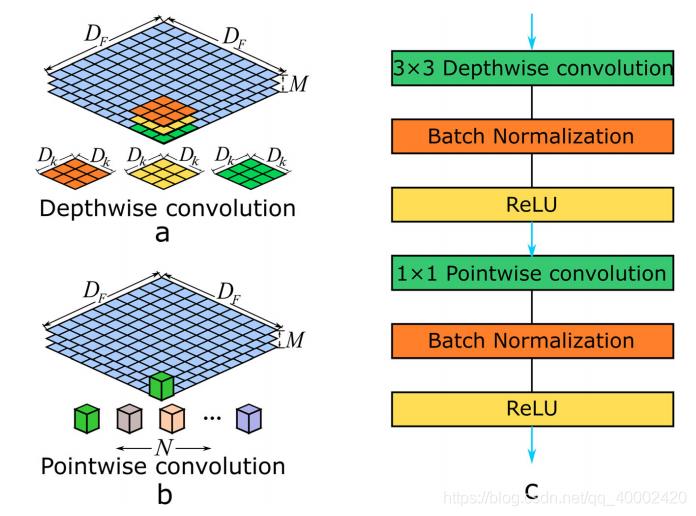
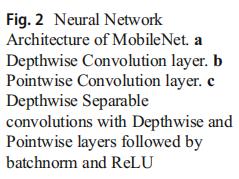

| 原文 | 译文 |
|---|---|
| Here, in our experiment for apple leaf diseases identification, we set width multiplier α = 1 and resolution multiplier ρ = 1. In the same situation, the computational cost CS of the standard convolutions can be obtained by Eq. 2: | Here, in our experiment for apple leaf diseases identification, we set width multiplier α = 1 and resolution multiplier ρ = 1. In the same situation, the computational cost CS of the standard convolutions can be obtained by Eq. 2: |

| 原文 | 译文 |
|---|---|
| Here, in our experiment for apple leaf diseases identification, we set width multiplier α = 1 and resolution multiplier ρ = 1. In the same situation, the computational cost CS of the standard convolutions can be obtained by Eq. 2: | 最后,为了将标准卷积表示为深度卷积和逐点卷积,我们方法中的减少 R 可以通过等式 3 计算: |

| 原文 | 译文 |
|---|---|
| The most important merit of this model is that it introduces two simple global hyper-parameters to balance the delay and accuracy effectively. These two hyper-parameters, width multiplier and resolution multiplier, allow the model builder to choose the right size model for the application according to the constraints of the problem. | 该模型最重要的优点是它引入了两个简单的全局超参数来有效平衡延迟和准确性。 这两个超参数,宽度乘数和分辨率乘数,允许模型构建器根据问题的约束为应用程序选择合适大小的模型。 |
| 原文 | 译文 |
| :– | :– |
| The most important merit of this model is that it introduces two simple global hyper-parameters to balance the delay and accuracy effectively. These two hyper-parameters, width multiplier and resolution multiplier, allow the model builder to choose the right size model for the application according to the constraints of the problem. | 该模型最重要的优点是它引入了两个简单的全局超参数来有效平衡延迟和准确性。 这两个超参数,宽度乘数和分辨率乘数,允许模型构建器根据问题的约束为应用程序选择合适大小的模型。 |
5 The high precision models for apple leaf diseases identification
| 原文 | 译文 |
|---|---|
| Actually, for obtaining an optimal solution for apple leaf diseases identification, we have tried several deep learning models. The main objectives include high precision and high efficiency. Of course, the balance of these two objectives is necessary. The MobileNet model introduced in previous section can be executed with high efficiency. On the other hand, in order to get a high inspection precision, we have tried ResNet152 [34] and InceptionV3 [35] for apple leaf diseases identification. In this section, we will simply introduce how to inspect apple leaf diseases using ResNet152 and InceptionV3. | 实际上,为了获得苹果叶片病害识别的最优解,我们尝试了几种深度学习模型。 主要目标包括高精度和高效率。 当然,这两个目标的平衡是必要的。 上一节介绍的 MobileNet 模型可以高效执行。 另一方面,为了获得较高的检测精度,我们尝试了 ResNet152 [34] 和 InceptionV3 [35] 进行苹果叶片病害识别。 在本节中,我们将简单介绍如何使用 ResNet152 和 InceptionV3 检测苹果叶片病害。 |
5.1 The ResNet152 model for apple leaf diseases identification
| 原文 | 译文 |
|---|---|
| ResNet was first proposed in 2015, the basic structure of this model consists of two convolutional layers. Meanwhile, this model skips blocks of convolutional layers by using a nonparameterized shortcut connection and adds new inputs into the network and generates new outputs. ResNet were proposed as a family of multiple deep neural networks with similar structures but different depths, i.e. ResNet18, ResNet34, ResNet50, ResNet101 and ResNet152. | ResNet 于 2015 年首次提出,该模型的基本结构由两个卷积层组成。 同时,该模型通过使用非参数化快捷连接跳过卷积层块,并将新输入添加到网络中并生成新输出。 ResNet 被提议为具有相似结构但不同深度的多个深度神经网络家族,即 ResNet18、ResNet34、ResNet50、ResNet101 和 ResNet152。 |
| ResNet 于 2015 年首次提出,该模型的基本结构由两个卷积层组成。 同时,该模型通过使用非参数化快捷连接跳过卷积层块,并将新输入添加到网络中并生成新输出。 ResNet 被提议为具有相似结构但不同深度的多个深度神经网络家族,即 ResNet18、ResNet34、ResNet50、ResNet101 和 ResNet152。 | 在本文中,我们选择 ResNet152 作为比较模型,因为它在 ResNet 系列中精度最高 [30]。 如图 3 所示,一个有病害的苹果叶子被输入到 ResNet152 模型中。 四列分别有10层、24层、108层、10层。 总共有152层。 在这里,虚线快捷方式增加了维度,虚线框内的层代表 n 个重复的卷积层。 例如,“虚线框 x 5”表示 5 个重复的卷积层。 |

5.2 The InceptionV3 model for apple leaf diseases inspection
| 原文 | 译文 |
|---|---|
| Inception is a module in GoogleNet. This model can perform multiple convolution operations or pooling operations on the input images in parallel and composing all the results into a very deep feature map. Therefore, its precision should be higher than general models. | Inception 是 GoogleNet 中的一个模块。 该模型可以对输入图像并行执行多个卷积操作或池化操作,并将所有结果组合成一个非常深的特征图。 因此,其精度应高于一般型号。 |
| The most effective model of Inception is Inceptionv3 architecture, which is the winner of 2014 ILSVRC, and has 44 layers with 21 million learnable parameters. As shown in Fig. 4, it is the model of InceptionV3 consists of 11 Inception modules. (a) is used in the 1th - 4th and the 10th -11th Inception modules of InceptionV3. (b) is used in the 5th - 9th Inception modules of InceptionV3. However, it is also a time-consuming model. In order to improve this problem, factorizing convolutions were proposed to reduce its parameters. For example, a 5 × 5 filter convolution can be decomposed into two 3 × 3 filter convolutions. Through this step, the parameters in this process reduces from 5 × 5 = 25 to 3 × 3 + 3 × 3 = 18. Thus, it brings 28% reduction in number of parameters. However, the calculation cost is still not able to full satisfy the requirements of efficiency for apple leaf diseases identification. The detail results of efficiency and precision of these models will be shown in Section 6. | Inception 最有效的模型是 Inceptionv3 架构,它是 2014 年 ILSVRC 的冠军,有 44 层,2100 万个可学习参数。如图 4 所示,是 InceptionV3 的模型,由 11 个 Inception 模块组成。 (a) 用于 InceptionV3 的第 1 ~ 4 和第 10 ~ 第 11 的 Inception 模块。 (b) 用于 InceptionV3 的第 5 至第 9 个 Inception 模块。然而,它也是一个耗时的模型。为了改善这个问题,提出了分解卷积来减少其参数。例如,一个 5 × 5 的滤波器卷积可以分解为两个 3 × 3 的滤波器卷积。通过这一步,这个过程中的参数从5×5=25减少到3×3+3×3=18,从而使参数数量减少了28%。然而,计算成本仍不能完全满足苹果叶片病害识别效率的要求。这些模型的效率和精度的详细结果将在第 6 节中显示。 |
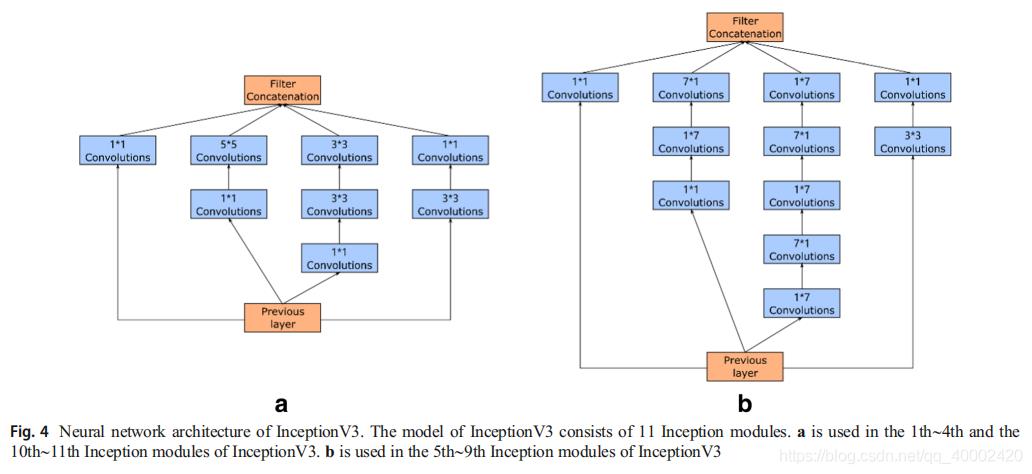
6 Experiments and results
6.1 Experimental setup
| 原文 | 译文 |
|---|---|
| This experiment was performed on an Ubuntu server (16.04 LTS) with an Intel ® Core™ i7-9700KF CPU @ 3.60GHz that was accelerated by an NVIDIA GeForce RTX 2080Ti GPU. NVIDIA GeForce RTX 2080Ti has 4352 CUDA cores and 11 GB memory. The core frequency is up to 1545 MHz. All the deep learning models used in this paper were implemented in the Tensorflow deep learning framework. | 该实验是在配备 Intel ® Core™ i7-9700KF CPU @ 3.60GHz 的 Ubuntu 服务器 (16.04 LTS) 上进行的,该 CPU 由 NVIDIA GeForce RTX 2080Ti GPU 加速。 NVIDIA GeForce RTX 2080Ti 拥有 4352 个 CUDA 核心和 11 GB 内存。 核心频率高达 1545 MHz。 本文中使用的所有深度学习模型都是在 Tensorflow 深度学习框架中实现的。 |
6.2 Dataset
| 原文 | 译文 |
|---|---|
A dataset containing 334 images were used for training and testing the MobileNet model. All of the images were collected by the agriculture experts who are visiting and surveying kinds of orchards in shaanxi Province. The dataset covers 2 common types of apple leaf diseases: Alternaria leaf blotch (caused by Alternaria alternata f.sp. mali) and rust (caused by Pucciniaceae glue rust). | 包含 334 张图像的数据集用于训练和测试 MobileNet 模型。 所有图片均由正在陕西省各类果园走访调研的农业专家采集。 该数据集涵盖了 2 种常见的苹果叶病害类型:链格孢叶斑病(由 Alternaria alternata f.sp. mali 引起)和锈病(由 Pucciniaceae 胶锈病引起)。 |
| In order to improve the precision of apple leaf diseases identification, an image generator object was created to perform random rotation, cutting, and grayscale on this dataset. By the above methods, the dataset is expanded. Meanwhile the identification precision will be greatly improved, especially in the case that the photos are taken in different rotation or scaling. Figure 5 shows representative images of the diseased apple leaves in the dataset. In total, the apple leaf dataset contains 2004 images. To perform the experiment, 75% of the dataset is used for training and the other 25% for testing. The ratio of the size of the training dataset to that of the validation dataset is 3:1. Table 1 lists the numbers of training sets and testing sets for apple leaf diseases identification. | 为了提高苹果叶片病害识别的精度,创建了一个图像生成器对象,对这个数据集进行随机旋转、切割和灰度处理。 通过上述方法,扩展了数据集。 同时识别精度将大大提高,尤其是在不同旋转或缩放比例的情况下。 图 5 显示了数据集中患病苹果叶子的代表性图像。 苹果叶数据集总共包含 2004 张图像。 为了执行实验,数据集的 75% 用于训练,另外 25% 用于测试。 训练数据集的大小与验证数据集的大小之比为 3:1。 表1列出了苹果叶片病害识别的训练集和测试集的数量。 |
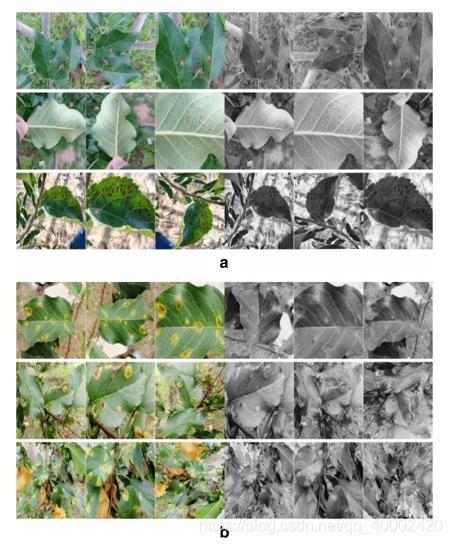
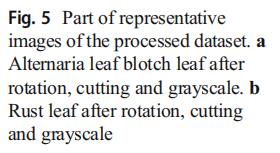
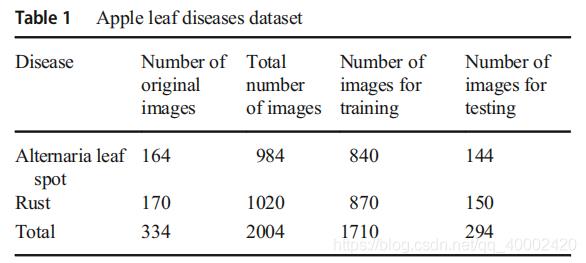
6.3 Experiment results and analysis
| 原文 | 译文 |
|---|---|
| In this section, we will give the testing results using three kinds of deep learning models, including MobileNet, InceptionV3, and ResNet152. The results will be demonstrated through the accuracy of convolution neural networks, and average handling time for each image. | 在本节中,我们将使用 MobileNet、InceptionV3 和 ResNet152 三种深度学习模型给出测试结果。 结果将通过卷积神经网络的准确性和每张图像的平均处理时间来证明。 |
| The average handing times are used to evaluate efficiency for apple leaf diseases identification. As shown in Table 2, MobileNet based method is the most efficient one, only 0.22 s is taken for each image. However, the apple leaf diseases identification time for the InceptionV3 model is more than 2 times than that of MobileNet model. Furthermore, the cost of ResNet152 is nearly 4 times than that of MobileNet model. Therefore, the efficiency of MobileNet model is the best one. | 平均处理时间用于评估苹果叶片病害识别的效率。 如表 2 所示,基于 MobileNet 的方法是最有效的方法,每张图像只需要 0.22 秒。 然而,InceptionV3 模型的苹果叶病害识别时间是 MobileNet 模型的 2 倍以上。 此外,ResNet152 的成本是 MobileNet 模型的近 4 倍。 因此,MobileNet 模型的效率是最好的。 |
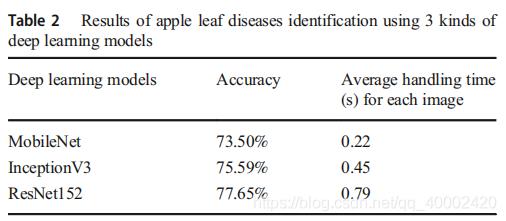
| 原文 | 译文 |
|---|---|
| Finally, the accuracy of these 3 models are nearly the same. Supposing the testing accuracy is represented by Atesting. It can be obtained by calculating the ratio between the number of corrected identified (Ncorrect) and the number of the total images (Ntotal), as Eq. 4. | 最后,这 3 个模型的准确率几乎相同。 假设测试精度用Atesting表示。 可以通过计算校正识别数(Ncorrect)与总图像数(Ntotal)的比值得到,如式4所示。 |

7 Conclusions and future works
| 原文 | 译文 |
|---|---|
| In this paper, a MobileNet based apple leaf diseases identification method is proposed. This method can greatly reduce the burden of experts for apple leaf diseases identification. It can offer a stable identification result. Meanwhile, it is a low-cost method, because it can be easily deployed in a mobile device. Furthermore, we also provide a good balance between the efficiency and precision, this is achieved through comparing several deep learning models. | 本文提出了一种基于MobileNet的苹果叶病害识别方法。 这种方法可以大大减轻专家对苹果叶片病害鉴定的负担。 它可以提供稳定的识别结果。 同时,它是一种低成本的方法,因为它可以很容易地部署在移动设备中。 此外,我们还在效率和精度之间提供了良好的平衡,这是通过比较几种深度学习模型来实现的。 |
| One of possible extension is to collect more datasets for further improving the identification precision. In our future plan, we are going to collect 2,000,000 images for all apple leaf diseases as a training dataset. This will greatly help us to develop a much more effective deep learning models for apple leaf diseases identification. | 一种可能的扩展是收集更多数据集以进一步提高识别精度。 在我们未来的计划中,我们将收集 2,000,000 张所有苹果叶病害的图像作为训练数据集。 这将极大地帮助我们开发更有效的苹果叶片病害识别深度学习模型。 |
| Another future work is to design a deep learning model to quality the apple leaf diseases. For example, we can give the different levels of two rust in Fig. 1. This is a challenge task, but it is an urgent requirement from agricultural experts. | 未来的另一项工作是设计一个深度学习模型来质量苹果叶病。 例如,我们可以在图 1 中给出两种锈病的不同程度。这是一项具有挑战性的任务,但却是农业专家的迫切要求。 |
以上是关于Paper翻译:《MobileNet Based Apple Leaf Diseases Identification》的主要内容,如果未能解决你的问题,请参考以下文章